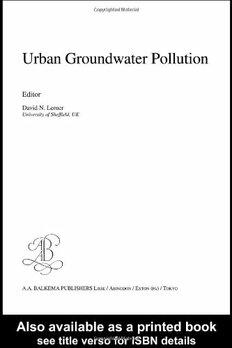
Urban Groundwater Pollution (Iah Intl Contr. to Hydro, Vol 24, Iah-Ich24) PDF
298 Pages·2003·5.9 MB·English
Most books are stored in the elastic cloud where traffic is expensive. For this reason, we have a limit on daily download.
Preview Urban Groundwater Pollution (Iah Intl Contr. to Hydro, Vol 24, Iah-Ich24)
Description:
More than 50% of the world's population already live in cities, and the proportion is rising extremely rapidly towards developed country levels of more than 90%. Groundwater from wells is the major source of water supply for many of these cities, however, groundwater is polluted by the cities that overlie it and sewerage systems are often absent, or leak. Industrial landuse implies the use of large quantities of chemicals, and it is the poor disposal and accidental spillage of these chemicals which results in the contamination of virtually every industrial site in the world. Much of this pollution migrates deeper to damage groundwater. Groundwater has slow turnover time, often measured in decades and centuries, reducing the self-cleansing capacity. Urban aquifers are therefore vitally important but very fragile, easily damaged and slow to repair. Urban groundwater problems and solutions vary greatly around the world. Mature cities often have remote and clean water supplies, good sewerage systems, strict controls on groundwater and land use, and declining industries. However, they have a legacy of more than one hundred years of waste disposal and industrially-contaminated land which continues to cause problems. Rapidly urbanising cities are frequently dependent on local groundwater and have poor sanitation and uncontrolled industry. These factors present many immediate risks to human health. This book explains the nature and value of urban groundwater, discussing the types of pollutants that are found, and their sources. The unique aspect of this book is the in-depth discussion of six different urban environments, complete with case studies. These environments are: Mature industrial cities; Arid-zone cities; Weathered crystalline aquifers in sub-Saharan Africa; Cities overlying karst aquifers; Alluvial aquifer systems; Shallow aquifers in Mediterranean climates.
See more
The list of books you might like
Most books are stored in the elastic cloud where traffic is expensive. For this reason, we have a limit on daily download.
